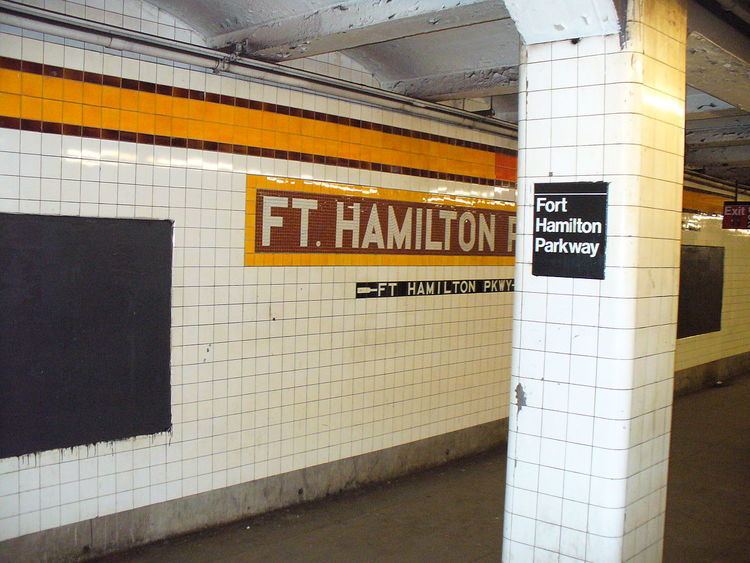Division B (IND) Transit connections MTA Bus: B103 Platforms 2 side platforms Borough Brooklyn | Line IND Culver Line Structure Underground Opened 7 October 1933 Locale Windsor Terrace | |
 | ||
Services F (all times)
G (all times) Address Brooklyn, NY 11218, United States Similar Church Avenue, Ditmas Avenue, 15th Street–Prospect Park, Bergen Street, Avenue P | ||
Fort Hamilton Parkway is a local station on the IND Culver Line of the New York City Subway. It is served by the F and G trains at all times.
Contents
Station layout
There are two local tracks and two side platforms. The unused express tracks run under the station and are not visible from the platforms. The tile band is orange-yellow with a medium red-brown border; the tablets are set in the reverse of this color scheme. Several replacement tiles in bright orange-red have been observed.
South of this station, on the express tracks on the lower level, there are bellmouths for a proposed subway line along Fort Hamilton Parkway and/or the parallel Tenth Avenue. After diverging into two lines at around 65th Street, the mainline would have terminated at 86th Street in Bay Ridge, and the other line would travel west from the mainline towards a partially-built tunnel to Staten Island. An alternate plan proposed a connection to the BMT West End Line at New Utrecht Avenue. These lines were planned as part of the IND Second System.
The IND Culver Line's Church Avenue and Fort Hamilton Parkway stations were the last underground stations to get fluorescent lighting on platform level, which replaced the incandescent lighting in 1987.
Exits
The full-time, northern entrance is by Greenwood and Prospect Avenues, with two street staircases and a block-long passageway northward to the northeast corner of Prospect Avenue and Reeve Place for one additional street staircase. There is a closed staircase that would have led to a fare control area at platform level at the Manhattan-bound side. This area is gated shut, and about half of the space is taken by station facilities with additional tiles.
The south end exit is to Fort Hamilton Parkway and has full-time HEET access and a former booth. The only exit at this end is a ramp (no staircase) that runs along the western side of the Prospect Expressway, up and down a small hill. This exit replaced the original 1933 staircase exit, when Robert Moses built the expressway. From the mezzanine area, one can see the variation in tile colors and styles when the new entrance was added in 1962, coinciding with the opening of the expressway. This can be seen when facing the ramp.
